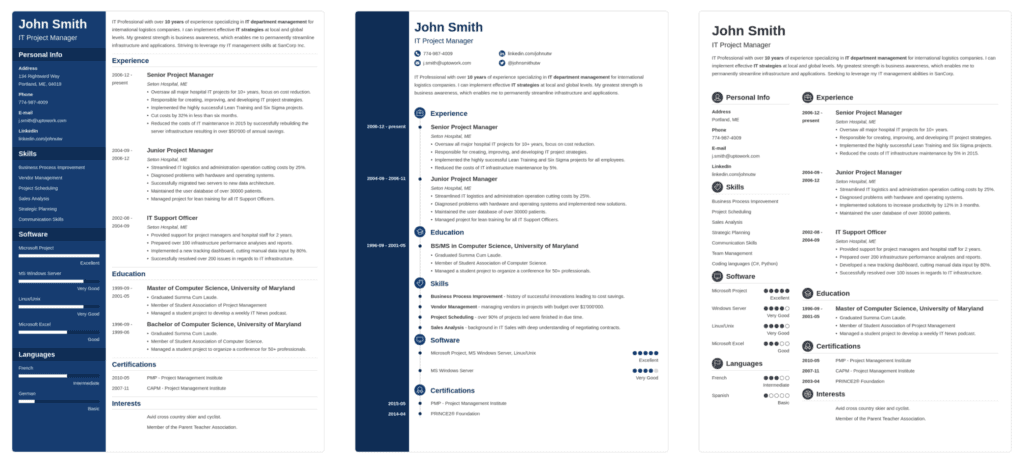Starting with a structure or outline is a great way to save time when writing your resume, which is why resume templates are so popular these days.
The question is, should you use a resume template for your own job search, or should you craft your resume from scratch?
The answer is both, and this article will explain why.
But First, What Exactly Is A Resume Template?
Before we can discuss using resume templates, we need to be on the same page about what they are.
Resume templates come in various file formats, each requiring specific software in order to open, edit and save. Some are Microsoft Word documents, some are Google Docs files, and others rely on dedicated niche software.
Here are some examples of resume templates:

These templates are created to solve one or both of the following challenges:
- They help with the design aesthetics of your resume, including layout, fonts, and colors, borders, icons, and other styling effects.
2. They help with the copy (or text) in your resume, ensuring you include the right information in the right order. They do this using “dummy text” to help guide you in the writing process.
Typically, though, most emphasis is placed on the design aspect, as this is what gets the most attention when catering to job seekers.
That’s The Problem With Most Resume Templates
Resume templates tend to prioritize a dazzling design at the expense of getting all the necessary information on the page or using an optimal structure to improve readability and flow.
When you use a resume template, you’re often forced to work within the boundaries set by that template.
In many cases, those boundaries hurt you more than they help you.
You can have the most beautiful-looking resume design a recruiter or employer has ever seen, but if it’s poorly written, badly structured, and riddled with unexplained gaps, it still goes in the trash.
As the saying goes, “you can put lipstick on a pig, but it’s still a pig.”
The point I’m making is this:
Most people choose resumes templates based solely on their appearance, while at the same time limiting themselves on the part that counts — the written contents of the resume.
The solution? Simple…
Write Your Resume From Scratch First
Open a blank Microsoft Word Document or Google Doc and start writing.
For now, forget about word counts and page counts. Forget about sections and formatting.
Your only goal at this stage is to get everything you need to say down on paper, including all the components that make up a winning resume.
Some of these being:
- Your name and contact details
- Your summary paragraph
- Your employment history
- Your skills (including soft and hard skills)
- Your education/qualifications
- Your hobbies and interests (if applicable)
- Any community involvement (if applicable)
- Any awards (if applicable)
From there, you’ll want to go through several rounds of editing.
This will include removing unnecessary information, consolidating repetitive points, shortening wordy sentences, swapping out words and phrases for simpler alternatives, and so on.
Essentially, all the principles that make for better writing apply to resumes.
By doing this stuff in this particular order, you remove the arbitrary limitations set by whatever resume template you decided on and ultimately give priority to content over everything else.
Then Plug Your Resume Into A Template
Only after you’ve completely written up your resume should you consider looking for a resume template.
Assuming you have, you can start looking for templates through a quick Google search.
Try searching the following:
- “free resume templates”
- “free resume designs”
- “resume and cover letter templates”
- “ms word resume templates”
- “google docs resume templates”
You can also look at various resume writers/builders, many of which include a long list of professional templates as part of their suite.
Something to be aware of, however:
Some templates simply won’t accommodate what you’ve written, the amount of text you have, the number of sections you have, the different aspects you’ve chosen to include, etc.
And that’s ok.
In fact, it’s great.
If you’re now having to eliminate templates based because they don’t provide an adequate platform to say what needs to be said, you’re doing it right.
After selecting a template, try pasting your written resume into the relevant sections without cutting sections or making significant compromises (that would obviously defeat the purpose of writing from scratch.)
With all this said, templates are and always will be optional.
A simple, text-based resume that’s properly sectioned, structured and formatted can be just as effective as any other resume.
Summary: Are Resume Templates Bad?
No, resume templates aren’t inherently bad.
Just remember, there’s no obligation for a resume template to follow any particular standards in terms of what they do and how they do it.
If you do decide to use one, you’ll need to apply those standards and choose a template that compliments the contents of your resume, not the other way around.
In other words, use them responsibly.